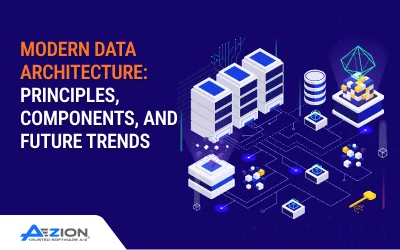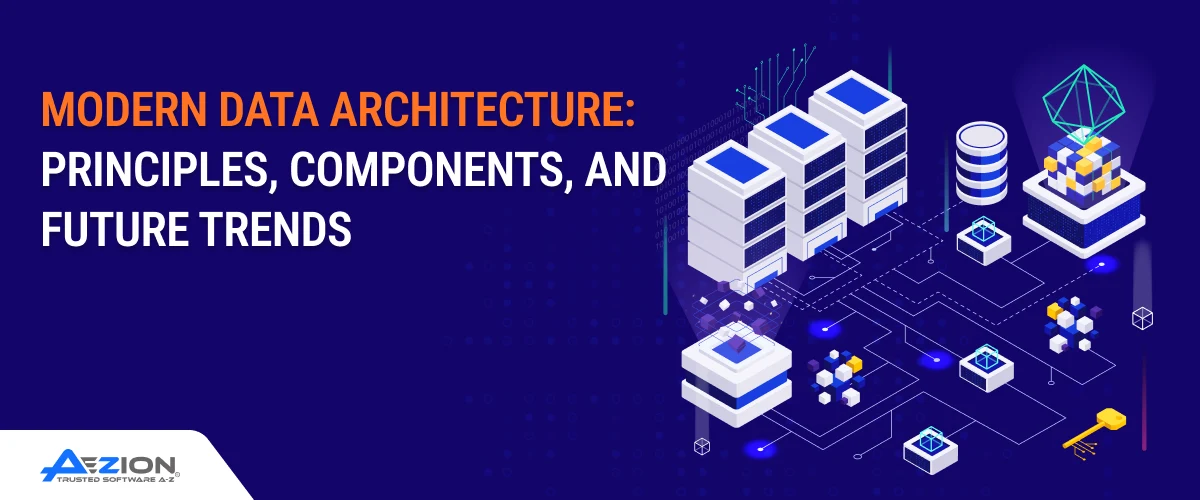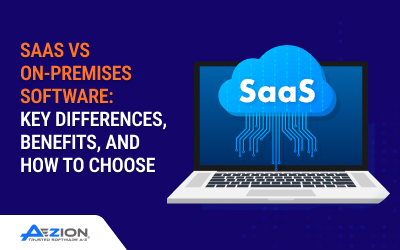Summary
Modern Data Architecture provides a structured foundation built to handle growing analytical demands and AI-related workloads. This blog examines the transition from traditional systems to contemporary frameworks, covering core components, guiding principles, and practical challenges in execution. It also highlights key modernization paths, types of architectural models, and important shifts likely to shape enterprise data environments in 2025.
Introduction
As data expands and business demands shift, older systems often fail to keep up. Modern Data Architecture responds with an adaptable structure that supports performance and oversight. It combines cloud-native tools, streaming processes, and decentralized data ownership beyond rigid pipelines and centralized setups. This blog explores the core components, foundational principles, and transition steps needed to support long-term data priorities.
The Need for Modern Data Architecture
Business owners today deal with all types of data, structured, semi-structured, and unstructured across all sources like CRM systems, IoT devices, social platforms, and cloud native applications. Legacy architectures often fail to deliver timely insights, scale cost-efficiently, or meet the governance demands. Modern Data Architecture addresses the said limitations with a modular and adaptable foundation, to support real-time analytics, cloud-first strategies, and changing compliance frameworks bridging the gap between business agility and technical complexity.
Data Modeling: Conceptual vs Logical vs Physical
Modern architectures depend on structured modeling to ensure data design consistency, scalability, and clarity. These models blueprint how data is organized, accessed, and governed. Understanding the distinction between conceptual, logical, and physical models helps architects plan better pipelines and storage strategies within a Modern Data Architecture framework.
Conceptual Data Model
The conceptual data model defines the high-level structure of the data, independent of technology or physical implementation. It focuses on entities, relationships, and core business rules. This model is ideal for aligning stakeholders on what data exists and how it interacts across domains, especially during early planning in Modern Data Architecture Consulting Services.
Logical Data Model
Logical models offer a more detailed view, including data attributes, types, and normalization rules, without binding them to specific platforms. It translates business concepts into technical structure and serves as a bridge between design and implementation, supporting scalable decisions in Modern Data Platform Architecture.
Physical Data Model
The physical data model maps the logical schema to actual storage systems. It includes tables, indexes, partitions, and performance considerations. In a Modern Data Warehouse Architecture, this model is crucial for optimizing queries, enforcing governance, and supporting integration with batch and real-time processing tools.
Evolution of Data Architecture
Data architecture has changed significantly from centralized setups to more adaptable, distributed frameworks. This shift mirrors a broader priority change from simply storing structured data to handling diverse formats and supporting continuous analysis. Tracking these changes helps build a sustainable and scalable modern data architecture that meets the demand of business governance agility.
Traditional Data Warehousing
Depending on the on-premises databases and fixed ETL pipelines, traditional architectures manage the structured data from transactional systems. This approach often results in rigid schemas and delayed batch reporting. While suited for consistent workloads, such systems fail to adapt to evolving business demands or integrate data from diverse sources.
Emergence of Big Data
The rise of the internet, mobile apps, and sensor data has introduced massive volumes of unstructured information. Hadoop and similar frameworks emerged to support distributed storage and batch processing. This phase focused on scale but often lacked integrated governance or real-time capabilities, limiting enterprise-grade adoption for Data Architecture Modernization.
Rise of Data Lakes and Lakehouses
Data lakes introduced schema-on-read and supported diverse data formats at low cost. However, poor governance and slow queries led to “data swamps.” Lakehouses aims to unify lakes and warehouses, combining low-cost storage with strong data management and supporting real-time analytics within Modern Data Warehouse Architecture frameworks.
Shift Toward Data Mesh and Data Fabric
Newer paradigms like data mesh promote domain ownership and product thinking, distributing data responsibilities across teams. Data fabric uses metadata and automation to unify access and governance. These models prioritize agility and integration and are foundational to any scalable Modern Data Architecture Consultant initiative.
Core Components of Modern Data Architecture
A proper Modern Data Architecture uses interoperable components that handle ingestion, storage, processing, governance, and analytics. Each element plays a role in maintaining performance, clarity, and accessibility throughout the data lifecycle, allowing technical and business teams to work efficiently with information.
Data Ingestion Tools
Data ingestion captures information from diverse sources and prepares it for processing. Both batch and real-time patterns are critical to creating a responsive Modern Data Architecture.
- ETL/ELT Pipelines: Apache NiFi, Fivetran, or dbt tools manage changes at multiple pipeline stages to align with cloud-native and hybrid workflows.
- Event Streaming (Kafka, Pulsar): Supports continuous data flow between systems while maintaining durability and throughput. Ideal for time-sensitive processing and distributed communication.
- Change Data Capture (CDC): Monitors incremental updates from source databases to reduce latency and eliminate the need for complete data reloads.
Storage Options
Storage in modern environments must support scalability, schema flexibility, and cost-efficiency. Data is often stored in layers for different access patterns and usage needs.
- Data Warehouses: Optimized for structured data and analytical queries, central to Modern Data Warehouse Architecture.
- Data Lakes: Handle semi-structured and unstructured formats with schema-on-read flexibility.
- Lakehouses: Combine Lake flexibility with warehouse reliability to enable unified analytics.
- Cloud Object Storage: Services like AWS S3 and Google Cloud Storage provide cost-effective, elastic storage options for massive datasets.
Data Processing Engines
Processing frameworks convert raw data into structured insights. Selection depends on latency needs, data volume, and the architecture’s analytics objectives.
- Batch (Spark, Hadoop): Suitable for transforming large datasets where latency is not a critical concern.
- Streaming (Flink, Kafka Streams): Processes data in motion, supporting near real-time decisions in operational systems.
Workflow Orchestration
Orchestration tools manage dependencies and scheduling of tasks across pipelines, ensuring data workflows are automated, observable, and fault tolerant.
- Apache Airflow: Popular for batch jobs using Directed Acyclic Graphs (DAGs).
- Dagster: Emphasizes type-aware, modular pipelines with strong testing support.
- Prefect: Cloud-native orchestration with enhanced failure handling and hybrid deployment models.
Governance and Metadata Management
Governance ensures data trust, discoverability, and compliance with regulations. Metadata tools track data lineage, access patterns, and policy enforcement.
- Data Catalogs (e.g., Alation, Collibra): Provide searchable metadata, ownership visibility, and data asset tagging.
- Lineage Tracking: Visualizes data flow across systems to support audit trails and debugging.
- Access Control and Policies: Role-based access, encryption rules, and data masking help protect sensitive information.
Analytics and BI
Analytics tools enable stakeholders to derive insights, visualize trends, and make decisions. Modern BI tools emphasize ease of use and self-service access.
- Self-Service BI Tools: Platforms like Power BI and Tableau allow non-technical users to explore data independently.
- Semantic Layers: Standardize metrics and KPIs across teams while hiding backend complexity.
- Embedded Analytics: Integrate data insights directly into applications or products to support contextual decision-making.
Key Design Principles of Modern Data Architecture
Designing an architecture that stands the test of time involves more than selecting the right tools. It calls for well-defined principles that promote adaptability, long-term growth, and oversight. These principles shape decisions across data storage, processing workflows, and access layers, allowing teams to create dependable systems that align with business objectives and meet current data regulations.
Cloud Native and Hybrid Flexibility
Cloud-native architectures offer elasticity, managed services, and faster provisioning. Hybrid flexibility allows teams to retain on-premises systems while extending capabilities through cloud storage and compute. This balance is vital in regulated or legacy-heavy environments that require phased adoption and long-term Data Architecture Modernization planning.
Decoupled Storage and Compute
Separating compute from storage allows independent scaling. This design improves cost efficiency and system reliability. Cloud data platforms like Snowflake and BigQuery adopt this principle, enabling diverse workloads from ad-hoc analysis to automated ML pipelines within a shared Modern Data Architecture.
Real-Time and Batch Data Processing
Successful architecture supports both real-time and batch modes. Real-time systems power alerts and dashboards, while batch jobs handle complex transformations and archival processing. Combining both improves responsiveness without compromising historical analysis or performance tuning.
Metadata-First Approach
Modern systems prioritize metadata to drive automation, observability, and governance. Metadata informs data lineage, sensitivity, and usage patterns. It also enables dynamic orchestration and compliance tracking, core requirements for Modern Data Architecture Consulting Services in regulated sectors.
Data Mesh and Domain Ownership
Data mesh decentralizes architecture by aligning ownership with business domains. Each team manages its data as a product, ensuring accountability, faster iteration, and reduced bottlenecks. This approach aligns architecture with operational realities and encourages a scalable, federated data model.
Security and Compliance by Design
Security must be integrated from the ground up. This includes encryption, access control, audit logging, and data classification. A proactive approach supports GDPR, HIPAA, and SOC 2 requirements, especially when deploying across cloud providers in a Modern Data Warehouse Architecture.
Criteria for a Successful Modern Data Architecture
Not every architecture qualifies as modern using cloud services or open-source tools. Success depends on how well the architecture meets business needs, scales with growth, and supports governance and collaboration. These criteria help evaluate whether an implementation meets the intent of a sustainable and future-ready design.
Scalability and Modularity
The architecture should grow as data volume, variety, and velocity increase, without disrupting operations. Modular design makes adopting new tools, replacing outdated components, or introducing additional data domains easy. This flexibility is a core requirement in any practical Modern Data Architecture Consultant evaluation.
Interoperability and Integration
Modern environments rely on multiple tools and platforms. Seamless integration through APIs, connectors, and standardized formats ensures that ingestion, storage, and analytics systems work in sync. Interoperability also enables collaboration across departments and simplifies expansion through external data partnerships.
Data Quality and Observability
Maintaining trust in data requires active monitoring. Built-in observability tracks data freshness, lineage, and anomalies. Combined with profiling and automated validation, this supports long-term usability and decision accuracy key benchmarks in enterprise-grade Modern Data Architecture deployments.
Governance and Access Control
Robust governance practices are non-negotiable. Access policies, identity management, audit logs, and data classification must be embedded into every layer. This ensures compliance while reducing risk, especially in hybrid environments and regulated industries using Modern Data Platform Architecture.
Challenges in Adopting Modern Data Architecture
Despite its advantages, transitioning to Modern Data Architecture comes with several challenges. These are not just technical, but often organizational and cultural. Recognizing these obstacles early helps build a realistic roadmap that minimizes disruption and accelerates value delivery across data teams.
Legacy Infrastructure Integration
Many organizations still depend on outdated systems with hardcoded logic, limited scalability, and proprietary formats. Integrating these systems with cloud-native tools requires custom connectors, refactoring, and often a staged migration. It slows transformation and increases risk during critical workloads, especially when modernizing data pipelines or analytics platforms.
Skills Gap and Cultural Shift
The shift to modern architecture demands new skills—data engineering, DevOps, streaming technologies, and distributed governance. In many cases, teams are accustomed to centralized ownership models. Bridging this gap takes time, dedicated training, and often external support from Modern Data Architecture Consulting Services.
Cost of Transformation
Initial investments in cloud services, training, and tool integration can be significant. Although modern platforms offer long-term operational savings, the upfront cost remains a barrier, especially for mid-sized organizations. Budgeting for phased implementation helps mitigate this issue without compromising the goal of Data Architecture Modernization.
Data Governance Complexity
As data democratization grows, so do security, access control, and lineage concerns. Decentralized ownership models demand distributed governance frameworks that are still maturing. Balancing agility with compliance becomes a key challenge, particularly in multi-cloud environments and heavily regulated sectors.
How to Modernize Your Data Architecture
Modernizing your data stack is not about adopting the latest tools—it’s about aligning architecture with business goals and operational efficiency. A structured approach helps minimize disruption and builds confidence across teams. Each phase contributes to long-term success in designing and maintaining Modern Data Architecture.
Assess Current State
The first step is to audit existing infrastructure, data flows, storage systems, and stakeholder pain points. Identifying bottlenecks, redundant pipelines, and governance gaps sets the foundation for transition. This assessment guides priority areas for applying Modern Data Architecture Consulting Services or internal capability enhancements.
Define Use Cases and Priorities
Business-driven use cases should dictate the architecture roadmap. Whether the goal is real-time reporting, AI model deployment, or data monetization, use cases clarify tool selection and sequencing. Prioritizing by impact and feasibility helps build momentum and stakeholder buy-in for Data Architecture Modernization.
Build Incrementally with Cloud-Native Tools
Rather than full-scale replacement, modernizing in phases reduces risk. Start by migrating non-critical workloads to cloud-native platforms, using modular ingestion, processing, and storage services. Managed tools in platforms like Snowflake, Databricks, or AWS Glue support incremental transformation while keeping operations stable.
Align Teams and Ownership
Cross-functional collaboration is key. Data engineering, analytics, security, and compliance teams must align under shared responsibilities and outcomes. Adopting domain ownership, shared KPIs, and data product thinking ensures consistency and accountability, central to any successful Modern Data Architecture Consultant engagement.
The Future of Data Architecture
The evolution of architecture is far from complete. Emerging trends point to a future defined by intelligent automation, composability, and decentralized control. These changes are not just technological; they reflect how organizations think about scale, innovation, and resilience. The future of Modern Data Architecture will be shaped by tools that learn, adapt, and abstract complexity from human workflows.
Data Fabric and Data Mesh Convergence
Data fabric automates integration across sources using metadata and AI. Data mesh decentralizes ownership by aligning data responsibilities with business domains. Their convergence supports agile access, better governance, and federated control, especially in distributed enterprises building toward long-term Modern Data Platform Architecture maturity.
AI-Augmented Data Management
AI is changing how organizations catalog, clean, and classify data. Tools powered by machine learning assist with lineage, anomaly detection, and schema inference. These capabilities reduce manual effort and accelerate delivery cycles, supporting more intelligent and adaptive Modern Data Architecture systems.
Composable and Modular Architectures
The shift from monolithic platforms to modular, API-first architectures is gaining traction. Composable systems allow teams to swap components without breaking core functionality. This flexibility is key to experimentation, scalability, and future upgrades, an essential direction for Modern Data Warehouse Architecture evolution.
Autonomous Data Platforms
Autonomous platforms promise automated provisioning, optimization, and monitoring across data stacks. They adapt to workload demands, enforce policies, and maintain performance with minimal human intervention. These platforms will play a critical role in enabling real-time governance and self-service analytics at a scale.
Conclusion
Building and scaling a Modern Data Architecture requires more than just tools; it demands a shift in mindset, governance, and design priorities. From data modeling to orchestration and real-time processing, each layer must work cohesively to support agility and long-term growth. Organizations that invest in modular, interoperable, and governed architectures position themselves to meet both current demands and future innovation. For those seeking expert alignment, partnering with a Modern Data Engineering Solutions provider ensures that strategy and execution align with business and technical objectives.
FAQs
What is the difference between legacy and modern data architecture?
Legacy architectures are monolithic, tightly coupled, and batch oriented. Modern architectures are modular, cloud-native, and designed for real-time access, scalability, and better governance across distributed environments.
How does modern architecture support AI/ML?
Modern designs support AI/ML by integrating scalable storage, real-time data pipelines, and metadata layers. This allows faster model training, better feature management, and seamless deployment across environments.
What tools are essential for a modern data stack?
Key tools include cloud data warehouses, data lakes, orchestration platforms, ingestion pipelines, processing engines, cataloging systems, and analytics interfaces. Tool choice depends on the use case, scale, and existing infrastructure.
Can modern data architecture work in a hybrid cloud?
Yes, many platforms are designed for hybrid deployments. These allow organizations to combine on-premises systems with public or private cloud services, ensuring flexibility and compliance with data residency policies.
What’s the first step to modernizing architecture?
Begin with a current-state assessment to identify performance gaps, tooling limitations, and team needs. Then, define high-impact use cases and prioritize them based on feasibility, value, and alignment with strategic goals.




